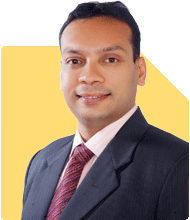Ramalingam Kalirajan |6504 Answers |Ask -Follow
Mutual Funds, Financial Planning Expert - Answered on Jul 06, 2024
He has an MBA in finance from the University of Madras and is a certified financial planner.
He is the director and chief financial planner at Holistic Investment, a Chennai-based firm that offers financial planning and wealth management advice.... more

I am 42 yr old my and my wife total income is 85000 . Our expenses two kids school fees 17000, EMI ( Personal Loan almost 7 lacs with different banks and 4 more years to pay) 30000 , rent 20000 , household expenses 20000 , Credit card bill extra. I can't able to save anything but overspending above income . I will not able to cut my rent , household expenses, kids fees . Pls tell me how can I manage.
Understanding Your Financial Situation
Monthly Income and Expenses:
Total Income: Rs. 85,000
School Fees: Rs. 17,000
EMI: Rs. 30,000
Rent: Rs. 20,000
Household Expenses: Rs. 20,000
Total Expenses: Rs. 87,000 (excluding credit card bills)
Identifying the Challenges
Your current situation shows an overspending of Rs. 2,000 per month, not including credit card bills. This indicates a need to control expenses and find ways to increase income.
Strategies for Managing Finances
1. Assess and Prioritize Expenses:
School Fees: Non-negotiable, but explore scholarships or educational grants.
EMI: Fixed, but consider consolidating loans for lower interest rates.
Rent: Fixed, but ensure you’re getting the best value.
Household Expenses: Evaluate and identify areas for cost-cutting.
2. Creating a Budget:
A detailed budget helps track spending and identify savings opportunities. Start by listing all income sources and fixed expenses. Then, allocate funds for variable expenses and savings.
3. Reducing Debt:
Consolidate Loans: If possible, consolidate personal loans to lower interest rates.
Negotiate Terms: Speak with banks to negotiate better EMI terms or temporary relief.
Credit Card Debt: Prioritize paying off credit card debt due to high-interest rates.
Increasing Income Streams
1. Explore Additional Income Opportunities:
Consider part-time jobs, freelancing, or consulting based on your skills. Small additional income can significantly impact your financial situation.
2. Upskill for Better Opportunities:
Invest in skills or certifications that can lead to higher-paying jobs. Online courses or professional training can enhance career prospects.
Financial Discipline and Smart Spending
1. Avoid Unnecessary Expenses:
Identify and cut down on non-essential spending. This includes dining out, entertainment, and impulsive purchases.
2. Use Cash or Debit Cards:
Limit the use of credit cards to avoid accumulating high-interest debt. Use cash or debit cards for everyday purchases.
3. Save on Utilities:
Implement energy-saving practices to reduce utility bills. Simple steps like turning off lights and using energy-efficient appliances can save money.
Effective Debt Management
1. Prioritize High-Interest Debt:
Focus on paying off high-interest debts first, such as credit cards. This reduces the overall interest burden.
2. Create a Debt Repayment Plan:
List all debts, interest rates, and EMIs. Create a plan to pay off high-interest debts first while maintaining minimum payments on others.
Building an Emergency Fund
1. Start Small:
Begin with a modest goal, like saving Rs. 5,000 per month. Gradually increase the amount as your financial situation improves.
2. Keep it Liquid:
Ensure the emergency fund is easily accessible. Use savings accounts or liquid mutual funds for this purpose.
Long-Term Financial Planning
1. Set Clear Financial Goals:
Define short-term and long-term financial goals. This could include debt-free living, children’s education, or retirement planning.
2. Invest Wisely:
Start investing in mutual funds or SIPs (Systematic Investment Plans) once debts are under control. This helps in wealth accumulation over time.
3. Plan for Children’s Education:
Invest in child-specific mutual funds or savings plans to secure your children’s educational future.
Insurance and Risk Management
1. Health Insurance:
Ensure you have adequate health insurance coverage for the family. This protects against high medical expenses.
2. Life Insurance:
Adequate life insurance is essential to provide for your family in case of an untimely event.
Regular Financial Review
1. Monitor and Adjust:
Regularly review your financial plan and adjust as needed. This helps in staying on track and making necessary changes.
2. Seek Professional Help:
If needed, consult a Certified Financial Planner (CFP) for personalized advice. They can provide tailored strategies for your situation.
Final Insights
Managing finances with a tight budget requires discipline and strategic planning. Here’s a summary of your action plan:
Action Plan Summary:
1. Evaluate Expenses:
Assess school fees, EMIs, rent, and household expenses to identify cost-saving opportunities.
2. Create a Budget:
Establish a detailed budget to track income and expenses, identifying areas for savings.
3. Reduce Debt:
Consolidate loans, negotiate terms, and prioritize paying off high-interest debts like credit cards.
4. Increase Income:
Explore additional income opportunities, upskill for better job prospects, and consider part-time jobs or freelancing.
5. Smart Spending:
Avoid unnecessary expenses, use cash or debit cards, and save on utilities to reduce costs.
6. Build an Emergency Fund:
Start small, keep the fund liquid, and gradually increase savings for unexpected expenses.
7. Long-Term Planning:
Set clear financial goals, invest wisely in mutual funds or SIPs, and plan for children’s education.
8. Insurance Coverage:
Ensure adequate health and life insurance coverage for the family’s financial security.
9. Regular Review:
Monitor and adjust your financial plan regularly, seeking professional help if needed.
By following this comprehensive plan, you can achieve financial stability and secure a brighter future for your family.
Best Regards,
K. Ramalingam, MBA, CFP
Chief Financial Planner
www.holisticinvestment.in
You may like to see similar questions and answers below
Moneywize |164 Answers |Ask -Follow
Financial Planner - Answered on Jan 15, 2024
Ramalingam Kalirajan |6504 Answers |Ask -Follow
Mutual Funds, Financial Planning Expert - Answered on Jun 18, 2024
Ramalingam Kalirajan |6504 Answers |Ask -Follow
Mutual Funds, Financial Planning Expert - Answered on Jul 15, 2024
Ramalingam Kalirajan |6504 Answers |Ask -Follow
Mutual Funds, Financial Planning Expert - Answered on Jul 16, 2024
Moneywize |164 Answers |Ask -Follow
Financial Planner - Answered on Oct 05, 2024
Milind Vadjikar |317 Answers |Ask -Follow
Insurance, Stocks, MF, PF Expert - Answered on Oct 05, 2024
Milind Vadjikar |317 Answers |Ask -Follow
Insurance, Stocks, MF, PF Expert - Answered on Oct 05, 2024
Ramalingam Kalirajan |6504 Answers |Ask -Follow
Mutual Funds, Financial Planning Expert - Answered on Oct 05, 2024
Dr Dipankar Dutta |653 Answers |Ask -Follow
Tech Careers and Skill Development Expert - Answered on Oct 04, 2024
Krishna Kumar |377 Answers |Ask -Follow
Workplace Expert - Answered on Oct 04, 2024
Krishna Kumar |377 Answers |Ask -Follow
Workplace Expert - Answered on Oct 04, 2024
Krishna Kumar |377 Answers |Ask -Follow
Workplace Expert - Answered on Oct 04, 2024
Krishna Kumar |377 Answers |Ask -Follow
Workplace Expert - Answered on Oct 04, 2024
Krishna Kumar |377 Answers |Ask -Follow
Workplace Expert - Answered on Oct 04, 2024
























